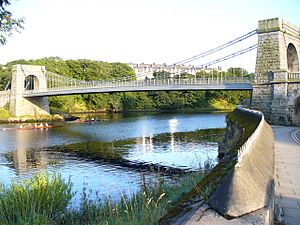Wellington Suspension Bridge facts for kids
The Wellington Suspension Bridge is a special type of bridge called a suspension bridge. It crosses the River Dee in Aberdeen, Scotland. This bridge connects the areas of Ferryhill and Craiglug. People sometimes call it the Chain Bridge or Craiglug Bridge.
It was designed by Captain Samuel Brown and the Aberdeen City Architect John Smith. The bridge first opened for people walking in November 1830. Cars and carriages could use it from May 1831. The bridge was closed to vehicles in 1984 and to walkers in 2002. But it was fixed up in 2006 and 2007. Since 2008, people can walk and cycle across it again.
History of the Bridge
In the early 1800s, the city of Aberdeen was growing very fast. Landowners in Torry wanted to make the most of this growth. They hoped to benefit from a new main road built in 1799. After some legal talks about who owned what land, things were settled.
In 1828, a special law was passed by the government. This law allowed a bridge to be built to replace the old Craiglug Ferry. Two famous architects, John Smith and Archibald Simpson, were asked to design the bridge. They also had to plan the roads leading to it.
John Smith worked with Captain Samuel Brown on the design. Smith designed the stone parts, and Brown designed the hanging parts of the bridge. The metal parts were made nearby at the Ferryhill Foundry. James Abernethy, a skilled engineer, watched over the building work.
In March 1830, the people in charge decided to name the bridge after a famous general. He was the Duke of Wellington. Even so, many people still call it the Chain Bridge or the Craiglug Bridge. Building started in 1829. People could walk on it by November 1830. Six months later, in May 1831, cars and carriages could use it too. The bridge cost about £10,000 to build.
How the Bridge Was Built
The bridge deck, which is the part you walk on, is about 67 meters (220 feet) long. It is also about 6.7 meters (22 feet) wide. Strong chains made of metal bars hold the deck up. These chains hang down in a curve. They are held by tall towers at each end.
The way the chains were put together was similar to a design by Thomas Telford. He used this method for his Menai Suspension Bridge in 1822. The chains were placed on both sides of the deck, one above the other. They dipped about 5.5 meters (18 feet) in the middle. An expert named James Slight said it was "the strongest bridge that Capt. Brown has yet erected." The chains themselves were made by a company called Thomson, Forman and Son.
The chains are held firmly in place by two large towers at each end. These towers have rounded archways. They were built from rough-cut granite stone. In 1886, the archway on the north side was changed a little. A stone with the date carved on it marks this change.
The roads leading to the bridge were also designed by John Smith. They were about 5 kilometers (3 miles) long. On the north side, there was a gentle slope from College Street. A new road also ran from Nigg to the south side of the bridge.
There was once an eight-sided building near the bridge. This was a toll house, where people paid to cross. It was also designed by Smith. It stood on the northwest corner of the bridge.
Fixing the Bridge: Restoration Work
The bridge had some repair work done in 1930. At that time, steel parts replaced the old cast iron and wrought iron parts. After this, only the main chains were left from the original bridge.
The old toll house was empty and falling apart by 1964. It was taken down soon after.
More repair work happened in 1984. This was after a new bridge, the Queen Elizabeth II bridge, was built nearby. The new bridge meant the Wellington Suspension Bridge could be closed to cars. But for safety reasons, it was also closed to people walking in 2002.
Later, engineers from Aberdeen City Council worked to save and strengthen the bridge. In 2008, it opened again for people to walk and cycle across. The main chains were still kept. The repair work was done in four steps. First, the main chains were fixed. Then, the wooden deck was replaced, and the bridge was repainted. The third step was cleaning and fixing the granite towers. Finally, special lights were added to show off the bridge at night. These repairs were expected to cost about £760,000. They were meant to make the bridge last for another 100 years.
In October 2007, city leaders learned that the cost for the first three steps had gone up to £995,000. The final lighting step was estimated to cost another £100,000.
From 1979 to 2010, the bridge was a "scheduled monument." This means it was a very important historical site. Since 2010, it has been a "Category A listed structure." This is the highest level of protection for historic buildings in Scotland.




